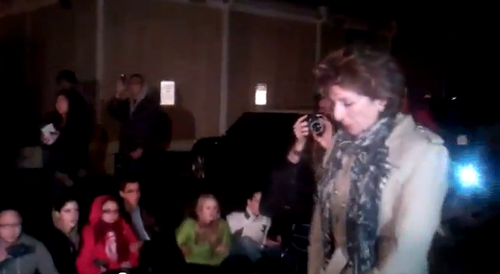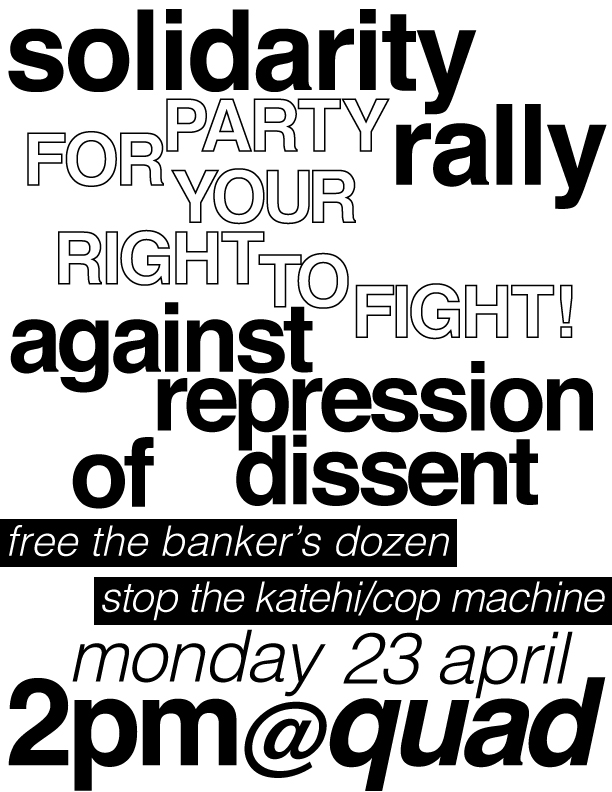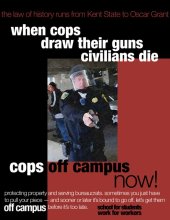Today the Reynoso Report was released. The distribution of this report, initially due within two months of the pepper-spray incident of November 18, has been much delayed. But the timing of its release is opportune, because this is precisely the moment for a serious, honest assessment of the conduct of the UC Davis administration with regard to campus protests against rising tuition and in defense of public education. This is the moment for such an assessment because twelve students and faculty, among them some of those pepper-sprayed on November 18, are currently facing serious criminal charges at the behest of the administration for their political activities on campus—charges which carry a possible jail term of eleven years. If an assessment of the administration’s approach to political activism at this crucial moment is to be both serious and honest, it will necessarily be blunt and uncompromising: in a word, excoriating. That is the tenor of the following letter, addressed to students, faculty, and staff at UC Davis and throughout the UC system.
The Reynoso Report is based on the fact-finding of Kroll Securities, and the manifest conflicts of interest inherent in the appointment of Kroll have been well documented. Thus we might reasonably expect Kroll’s report to offer something like a best-case assessment of the administration’s involvement in the pepper-spray affair. And indeed, the fact-finding upon which the report is based is often middling and ineffectual. On the key issue of the Chancellor’s actual orders on and prior to November 18, it has very little to say. Rather, it relies primarily upon an interview with the Chancellor conducted after the fact, on December 20, to gauge her position. Given the international condemnation the Chancellor was facing at that time, no one should be surprised to find her remarks composed of efforts at self-serving revisionism. The report states openly that Kroll “relied upon UC Davis in the area of document production; it was deemed infeasible for budgetary, timing, and other reasons for Kroll to conduct an independent, systemic forensic review and analysis of UC Davis servers, hard drives, and electronic devices.” In other words, only those documents (such as administrative emails) that UC Davis itself offered for inspection were reviewed. In short, on the key matters of concern we might expect the report to address, Kroll’s fact finding leaves serious omissions.
Nevertheless, the information we
are offered in the report amounts to a damning portrait of administrative malice, stupidity, incompetence, and immaturity.
1) The report makes clear that Chancellor Katehi and other senior administrators propped up their decision to evict the Occupy UC Davis encampment with fear-mongering based on the fallacious claim that numerous “non-affiliates” of the university were involved in the camp, ignoring and rejecting clear statements to the contrary by their own staff.
2) The report makes clear that Chancellor Katehi insisted on the removal of tents from the quad by police with no legal basis for such a police action, and that there were thus no legitimate grounds for ordering a police operation at all.
3) The report makes clear that Katehi ignored the concerns of her own staff and of the police that attempting to evict the encampment at 3:00pm on Friday afternoon would lead to a confrontation.
4) The report makes clear that, despite the Chancellor’s belated claim of November 21 that she ordered the police not to use force, the Chancellor made no concrete effort whatsoever to avoid the use of police force against demonstrators on November 18.
In short, the report makes clear that the so-called “Leadership Team,” and particularly the Chancellor, acted in a flagrantly totalitarian fashion. The Chancellor promulgated falsehoods concerning the basis for police action; she ignored the lack of legal grounds for such an action; she overruled objections to the timing of the eviction; and she made no reasonable effort to avoid police violence against students.
Since the Chancellor has been calling upon us to wait for the findings of the report before passing judgment concerning the events of November 18, let’s assess its conclusions and pass judgment accordingly. Its “key finding” is unequivocal:
While the deployment of the pepper spray on the Quad at UC Davis on November 18, 2011 was flawed, it was the systemic and repeated failures in the civilian, UC Davis Administration decision-making process that put the officers in the unfortunate situation in which they found themselves shortly after 3 p.m. that day.
This means that it is the “Leadership Team” of the UC Davis Administration, not the police, which bears primary responsibility for what happened on November 18. With the faintest glimmer of urbane wit, the report finds that “the actions of the Leadership Team provide a case study in how not to make important institutional decisions.”
For the sake of clarity, let’s summarize the report’s findings apropos of the points listed above.
1) On the matter of the supposed threat posed by “non-affiliates”:
When explaining their decisions on Nov. 17 and 18, UC Davis administrators repeatedly referenced this concern about individuals not affiliated with the university at Occupy movement protests and encampments on campus, and the security risks created by their presence. Indeed, in Chancellor Katehi’s letter distributed to campus protesters on Nov. 18, the day of the pepper spray incident, theChancellor wrote “We are aware that many of those involved in the recent demonstrations on campus are not members of the UC Davis community. This requires us to be even more vigilant about the safety of our students, faculty and staff.” As our report will indicate these concerns were not supported by any evidence obtained by Kroll.
….
Leading up to the eviction, Chancellor Katehi and Vice Chancellor Meyer were not swayed by the reports from Student Affairs staff that the Occupy activists were overwhelmingly comprised of students.
2) On the absence of legal justification for police action:
It is clear that the UCDPD leadership was concerned about its legal authority to remove the tents, at least during the daytime. It is equally clear that the UC Davis Administration was adamant that it did not want tents on campus and that the tents were considered a threat to health and safety. Just as the Leadership Team ultimately failed to arrive at a policy that appropriately constrained the conduct of campus police, so too did it fail to press for a definitive legal assessment of the scope of its authority to order the removal of the tents. In the course of its investigation, Kroll has been unable to identify the legal basis for the decision of the Leadership Team to act against the protesters and for theoperation mounted by the UCDPD. It appears that the UCDPD mounted its operation absent the clarity of legal authority under pressure from the Administration to do something to get rid of the tents.
3) On the administration’s failure to heed warnings about the probability of a police confrontation with students if the eviction was carried out at 3:00pm on Friday afternoon:
In the 24 hours before the police operation commenced, both Student Affairs staffers and campus police provided warnings to members of the Leadership Team that a confrontation might occur between activists and police on the Quad. These warnings do not appear to have impacted the decision-making of the Leadership Team, however….While the Chancellor viewed herself as chairing a consensus-driven discussion, her subordinates instead heard her issue an executive order. By insisting that the tents not be allowed to stay up on Friday night, Chancellor Katehi did in fact make a tactical decision: that the tents would be removed during the day….Based on the accounts of several officers, including Lieutenant Pike, Chief Spicuzza informed her officers that key and controversial decisions, including the 3 p.m. time for the operation, had been made by Chancellor Katehi herself.
4) On the Chancellor’s failure to pursue any real measures that might prevent the use of force against students:
Chancellor Katehi failed to express in any meaningful way her expectation that the police operation was to be sharply limited so that no use of force would be employed by police officers other than their demand that the tents be taken down….Vice Chancellor Meyer explained that “he did not understand that Chancellor Katehi believed that no force at all would be employed in taking down the tents until her comments following the November 18 police action.”…No members of the Leadership Team took responsibility for ensuring that all the members of the Team including the Police Chief had a common understanding of the scope and conduct of the police operation to be executed on Nov. 18.
These are devastating conclusions. Not only do they indicate unacceptable failures of leadership on the part of the Chancellor and other senior administrators, they indicate a willful disdain for the facts of the situation and a complete lack of effort to avoid the sort of outcome we witnessed on November 18. The report finds that “there was no immediate need to order the police to take down the tents on Friday, Nov. 18.” But despite the fact that “possible alternatives for protecting students in the encampment seem almost self-evident,” “the administration decided to deploy police to remove the tents on Nov. 18 before considering possible alternatives.” The Reynoso Report makes it clear that the UC Davis Administration acts in an extra-legal fashion, deploying the police force at their disposal without justification while criminalizing those who act against their policies.
Given the gravity of these charges, what do we find in the report which might account for the decisions of the Chancellor and her “Leadership Team”? Here we turn from tragedy to comedy, encountering statements from senior administrators of such frivolous stupidity and lugubrious immaturity that it is difficult to believe they could be made by people attempting to defend the validity of their leadership at a major research university.
On the inconvenient dearth of so-called “non-affiliates” at the encampment, Vice Chancellor Wood states: “students for us range all the way from eighteen…through the graduate postdoc, they could be 30 and be a student….I want to be fair that someone might see a pretty scruffy older person [and] presume them not a student.” I’m afraid this is indeed the caliber of seriousness and rigor—scruffy or not scruffy?—upon which the most important administrative judgments are based at UC Davis.
But let’s turn to Chancellor Katehi’s gravely earnest explanation of why tents just could not be allowed to remain on the quad for even one more night. Perhaps we might encounter a finer degree of reasoning from someone of so high a station:
We were worried at the time about that because the issues from Oakland were in the news and the use of drugs and sex and other things, and you know here we have very young students…we worried especially about having very young girls and other students with older people who come from the outside without any knowledge of their record.
The best rationale our Chancellor can come up with (after a month’s reflection) for a major police operation against non-violent student protesters is “the use of drugs and sex and other things” in the midst of “very young girls.” This is the sort of thing, or so she has heard, that goes on in “Oakland.”
But if this is utterly laughable nonsense in the context of university life, where football games and fraternity parties give rise to all kinds of “drugs and sex and other things” among “affiliates” and “non-affiliates” who “come from the outside,” perhaps Vice Chancellor Meyer has something more intelligent to say?
Our context at the time was seeing what’s happening in the City of Oakland, seeing what’s happening in other municipalities across the country, and not being able to see a scenario where [a UC Davis Occupation] ends well . . . Do we lose control and have non-affiliates become part of an encampment? So my fear is a long term occupation with a number of tents where we have an undergraduate student and a non-affiliate and there’s an incident. And then I’m reporting to a parent that a non-affiliate has done this unthinkable act with your daughter, and how could we let that happen?”
Ah, once again, “the City of Oakland”—what sort of people might one find there? And is it not the case that what was actually happening in the City of Oakland and other municipalities was egregious police violence against peaceful demonstrators—including the near-killing of protester Scott Olsen in Oakland on October 25? And what is it, exactly, that our tepid Vice Chancellor has in mind when he refers to “this unthinkable act” that might transpire between an undergraduate and a “non-affiliate”? Does he mean rape? It seems this is either a concept he does not to understand (“with your daughter,” he says) or a word he is unable to use in a sentence. But perhaps he just means “sex and other things”? Perhaps the very notion that an undergraduate—and a “daughter” no less—might have sex with a “non-affiliate” is an unthinkable act in the view of our painstakingly upright administrators.
That is to say: all that the pathetic and infantile discourse of the “Leadership Team” has to offer in its defense is the danger of sex and drugs, of “older people,” and the terribly frightening specter of “Oakland.” One needn’t look far to find an identical sexist, paternalist, pseudo-moralist discourse deployed in the most unbearably racist, xenophobic contexts. It is always the same thing with authoritarian bureaucrats who send in police to guard the young and innocent against those who “come from the outside”: they are more than willing to sanction brutal violence to buttress whatever obscene fantasy of purity serves as their faulty moral compass.
Let’s be honest then: whatever the “Leadership Team” of the UC Davis Administration says to legitimize its actions only certifies its illegitimacy by pointing up its remarkable stupidity, its dangerous incompetence, its apparent inability to say anything even remotely credible. These are people who have nothing to do with what a university is supposed to stand for—except to the extent that they directly oppose and obstruct it.
At the moment, the Chancellor and her totalitarian administration have only one claim upon legitimacy: the failure of an Academic Senate ballot measure expressing no-confidence in her leadership, and the success of a ballot measure accepting her “good faith apology.” Over 110,000 people signed a petition calling for Chancellor Katehi’s resignation. But 697 faculty, after all, voted against the no-confidence measure. 442 faculty voted to accept the Chancellor’s apology. Surely, then, this is all the information we need to affirm the Chancellor’s right to remain at her post? But let’s look at the results of another ballot measure, which:
1) condemns both the dispatch of police and use of excessive force in response to non-violent protests on November 18, 2011
2) opposes violent police response to non-violent protests on campus
3) demands that police deployment against protestors be considered only after all reasonable efforts have been exhausted and with direct consultation with Academic Senate leadership.
It turns out that 343 faculty voted against this ballot measure, a shameful fact for those of us who call these people our colleagues. This result makes it very likely that over 300 of those who accepted the Chancellor’s apology or who expressed confidence in her leadership also voted against condemnation of and opposition to the excessive use of force by police, or the consideration of alternatives to the use of police force. With friends like these, the Chancellor finds herself among the only company suitable to uphold the authoritarianism of her administration: the sort of people who are happy to support police violence against students.
Meanwhile, the Chancellor’s “good faith apology” to students pepper-sprayed in the fall now takes the form of an effort to have those same students prosecuted for their blockade of the US Bank branch on campus: another principled and courageous stand against the privatization of the university. Subject to international humiliation for her malfeasance in November, the Chancellor has reached out to student protesters in March by trying to destroy their lives through criminal charges. This is what the “good faith” of the administration amounts to.
Enough is enough. The Chancellor has made it clear that she will cling to her station by any means necessary. But the case against her is now so overwhelmingly clear it brooks no argument. Since the Chancellor has called for “healing,” let me offer a prescription: those of us among faculty, students, and staff who care about the university and about the demonstrators who stand up for it should immediately organize an ongoing picket and blockade of Mrak Hall, until the Chancellor is forced off the UC Davis campus—just as Chancellor Birgeneau tendered his resignation when faced with a picket of California Hall over retroactive charges against those beaten by police at Berkeley.
Surely this is the only genuine way the Chancellor’s disingenuous calls for “healing” can be answered.
Of course the Chancellor will find this proposal, and this letter, “uncivil.” But now that we finally have documentation of the hollowness of her words and the culpable folly of her actions, we can cut once again through the drivel with which she insistently responds to the most serious allegations.
Katehi: get out.
—
Nathan Brown
Assistant Professor
Department of English
Program in Critical Theory
University of California at Davis







